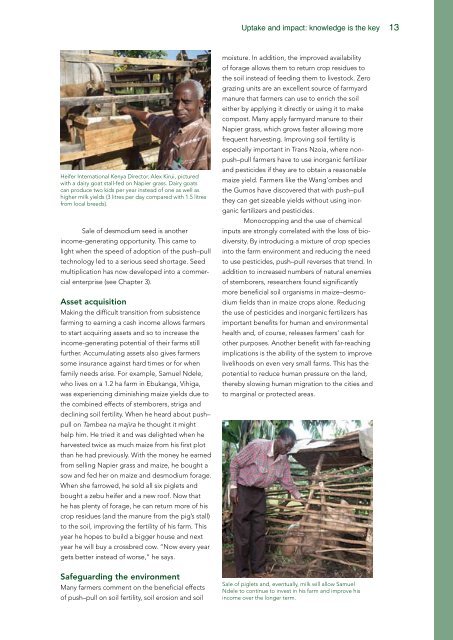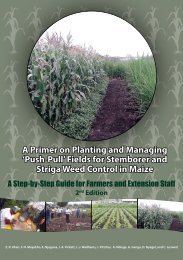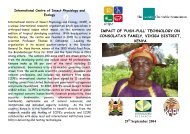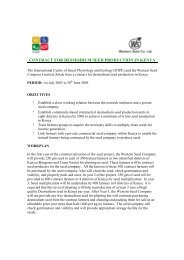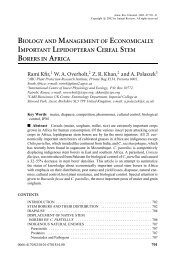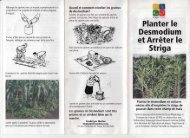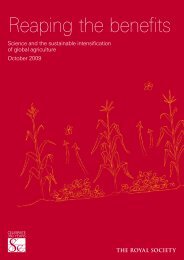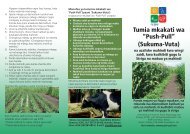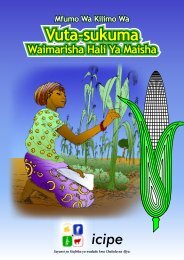a model for Africa's green revolution - Push-Pull
a model for Africa's green revolution - Push-Pull
a model for Africa's green revolution - Push-Pull
Create successful ePaper yourself
Turn your PDF publications into a flip-book with our unique Google optimized e-Paper software.
Uptake and impact: knowledge is the key 13<br />
Heifer International Kenya Director, Alex Kirui, pictured<br />
with a dairy goat stall-fed on Napier grass. Dairy goats<br />
can produce two kids per year instead of one as well as<br />
higher milk yields (3 litres per day compared with 1.5 litres<br />
from local breeds).<br />
Sale of desmodium seed is another<br />
income-generating opportunity. This came to<br />
light when the speed of adoption of the push–pull<br />
technology led to a serious seed shortage. Seed<br />
multiplication has now developed into a commercial<br />
enterprise (see Chapter 3).<br />
Asset acquisition<br />
Making the difficult transition from subsistence<br />
farming to earning a cash income allows farmers<br />
to start acquiring assets and so to increase the<br />
income-generating potential of their farms still<br />
further. Accumulating assets also gives farmers<br />
some insurance against hard times or <strong>for</strong> when<br />
family needs arise. For example, Samuel Ndele,<br />
who lives on a 1.2 ha farm in Ebukanga, Vihiga,<br />
was experiencing diminishing maize yields due to<br />
the combined effects of stemborers, striga and<br />
declining soil fertility. When he heard about push–<br />
pull on Tambea na majira he thought it might<br />
help him. He tried it and was delighted when he<br />
harvested twice as much maize from his first plot<br />
than he had previously. With the money he earned<br />
from selling Napier grass and maize, he bought a<br />
sow and fed her on maize and desmodium <strong>for</strong>age.<br />
When she farrowed, he sold all six piglets and<br />
bought a zebu heifer and a new roof. Now that<br />
he has plenty of <strong>for</strong>age, he can return more of his<br />
crop residues (and the manure from the pig’s stall)<br />
to the soil, improving the fertility of his farm. This<br />
year he hopes to build a bigger house and next<br />
year he will buy a crossbred cow. “Now every year<br />
gets better instead of worse,” he says.<br />
moisture. In addition, the improved availability<br />
of <strong>for</strong>age allows them to return crop residues to<br />
the soil instead of feeding them to livestock. Zero<br />
grazing units are an excellent source of farmyard<br />
manure that farmers can use to enrich the soil<br />
either by applying it directly or using it to make<br />
compost. Many apply farmyard manure to their<br />
Napier grass, which grows faster allowing more<br />
frequent harvesting. Improving soil fertility is<br />
especially important in Trans Nzoia, where nonpush–pull<br />
farmers have to use inorganic fertilizer<br />
and pesticides if they are to obtain a reasonable<br />
maize yield. Farmers like the Wang’ombes and<br />
the Gumos have discovered that with push–pull<br />
they can get sizeable yields without using inorganic<br />
fertilizers and pesticides.<br />
Monocropping and the use of chemical<br />
inputs are strongly correlated with the loss of biodiversity.<br />
By introducing a mixture of crop species<br />
into the farm environment and reducing the need<br />
to use pesticides, push–pull reverses that trend. In<br />
addition to increased numbers of natural enemies<br />
of stemborers, researchers found significantly<br />
more beneficial soil organisms in maize–desmodium<br />
fields than in maize crops alone. Reducing<br />
the use of pesticides and inorganic fertilizers has<br />
important benefits <strong>for</strong> human and environmental<br />
health and, of course, releases farmers’ cash <strong>for</strong><br />
other purposes. Another benefit with far-reaching<br />
implications is the ability of the system to improve<br />
livelihoods on even very small farms. This has the<br />
potential to reduce human pressure on the land,<br />
thereby slowing human migration to the cities and<br />
to marginal or protected areas.<br />
Safeguarding the environment<br />
Many farmers comment on the beneficial effects<br />
of push–pull on soil fertility, soil erosion and soil<br />
Sale of piglets and, eventually, milk will allow Samuel<br />
Ndele to continue to invest in his farm and improve his<br />
income over the longer term.


